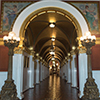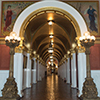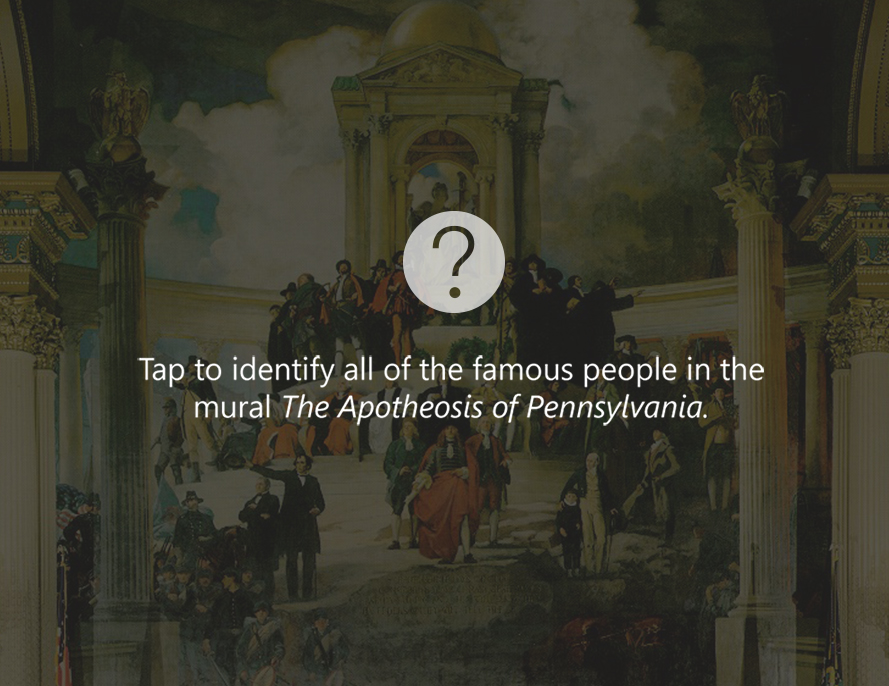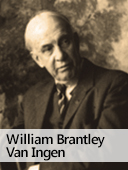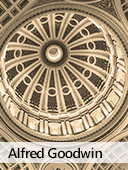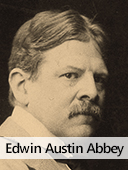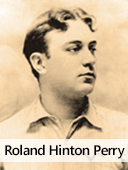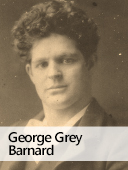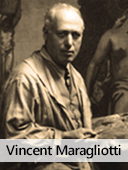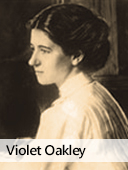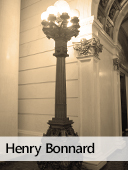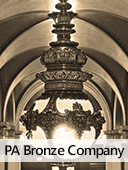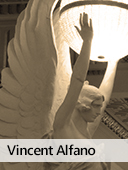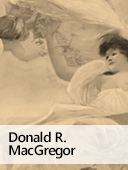![]()
![]()
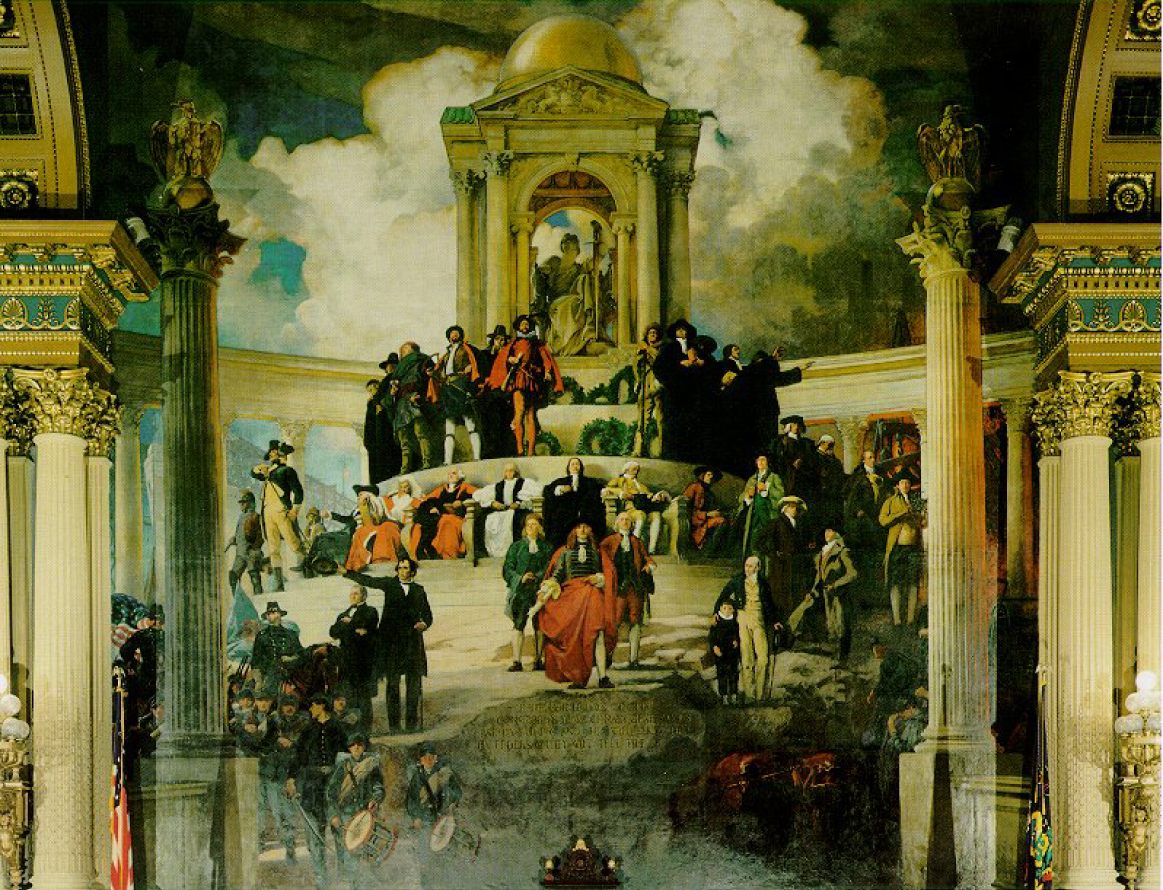






























1644-1718
The founder of Pennsylvania, served as Governor and in 1682 presided over the first Provincial Assembly, which later became the state House of Representatives.

1706-1790
Franklin was speaker of the Pennsylvania Assembly, signed the Declaration of Independence and Constitutions of Pennsylvania and the United States.

1734-1806
He was a financier of the American Revolution, a member of the first U.S. Senate, and established the first Bank of North America.

1824-1886
He was a Norristown native called “Hancock the Superb” at the Battle of Gettysburg and unsuccessfully ran the U.S. presidency in 1880.

1815-1872
He was a Philadelphian and victorious commander at the Battle of Gettysburg.

1817-1894
He was a Bellefonte native who was elected as the first Republican Governor shortly before the onset of the Civil War.

1792-1868
He served in the state House for eight years before gaining fame as an abolitionist and U.S. Congressman.

1750-1831
A French immigrant who served briefly as a Philadelphian councilman, was a philanthropist and banker who helped finance the War of 1812. Girard College for Orphans was constructed and endowed from his trust and named after him.

1699-1777
He stands next to his son, William Bartram (1739-1823). The father and son were pioneer botanists in the Philadelphia area, and John’s father served as an Assembly member.

1755-1819
A Philadelphia inventor-designer, built the first American steam engine.

1761-1818
He was an outstanding physician, surgeon and chemist at the University of Pennsylvania.

1737-1809
He served as Chief Clerk of the Assembly from 1779-1780 and became famous as a propagandist and pamphleteer of the Revolution.
1746-1813
He established the nation’s first free medical clinic at Pennsylvania Hospital, was a member of the Continental Congress, and a signer of the Declaration of Independence. He founded Dickinson College.

1732-1796
He was an astronomer, clockmaker and mathematician. He was director of the U.S. Mint from 1792-1795. Philadelphia’s Rittenhouse Square is named after him.

1743-1798
He was a steamboat inventor from Bucks County.

1792-1864
He served as Philadelphia mayor, state Deputy Attorney General and U.S. Senator and was the only Vice President from Pennsylvania (1845-1848).

1746-1807
He was known as the “fighting Parson” from Montgomery County, served in the U.S. House of Representatives and the U.S. Senate.

1748-1836
He was the first Protestant-Episcopal Bishop in Philadelphia and served as Chaplain of the Continental Congress and Chaplain of the U.S. Senate.

1727-1803
He was the first Provost of the University of Pennsylvania.

1734-1817
He was a signer of the Declaration of Independence and a Chief Justice for 22 years. He served as Governor from 1799 to 1808 and was a pioneer and advocate of free public schools.

1732-1808
He was an Assembly member and a signer of the U.S. Constitution, served as President of Pennsylvania before there was a Governor’s office.

1745-1796
He an Assembly member, was a Chester County general in the American Revolution and a frontier fighter who explored northwest Pennsylvania.

1580-1638
He bought Manhattan for $24 for the Dutch in 1626 and founded New Sweden on the Delaware River in 1638.

1575-1611
He was a Dutch ship captain and explorer who discovered the Delaware Bay and the Hudson River.

1552-1618
He was an English explorer, poet, courtier and politician.

1734-1820
He was born near Reading, was the legendary “pathfinder” of the Cumberland Gap and noted outdoorsman.

1651-1720
He was founder of Germantown and a religious leader, lawyer, and early Assembly member.

1673-1708
He was a religious leader in Philadelphia during William Penn’s lifetime.

Figure representing the “Genius of State”
The Capitol's green and gold hemispheric opalescent glass dome in the Supreme Court Chamber was created by Alfred Godwin of Philadelphia. Godwin emigrated from England in 1874 where he had received his training in stained glass. In 1891 he ran an advertisement in the directory listing his shop address at 1325 Market Street, Philadelphia. He also produced windows for several churches including the former Presbyterian Church on Market Square in Philadelphia. It is surmised that Godwin also created the ochre stained glass windows in the rotunda's upper dome, the light court skylights, the light court lunette openings on the Capitol's fifth floor, and the decorative ceiling glass in the House and Senate galleries. All of the glasswork in these areas, along with the leaded glass skylights on the fourth floor, are indicative of Godwin's style of work.
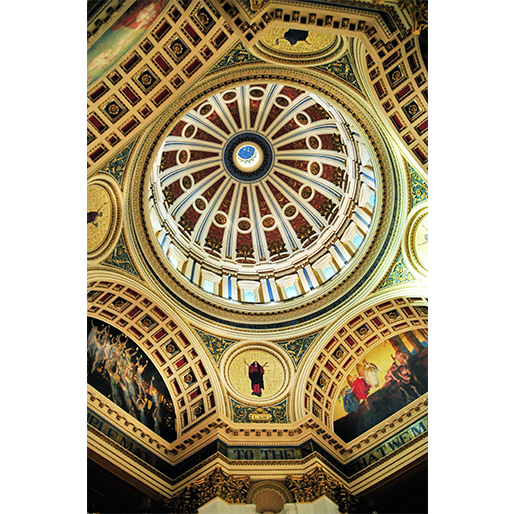
ROTUNDA
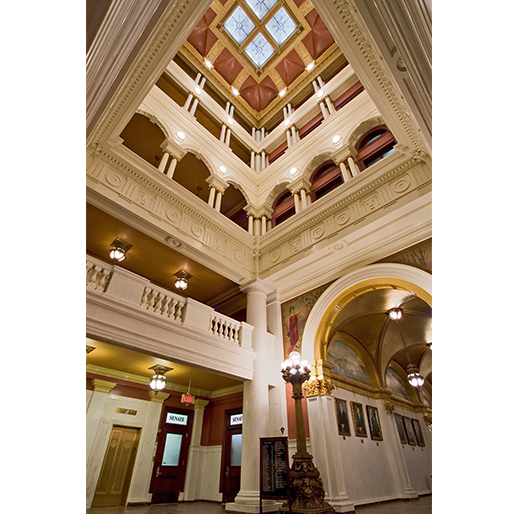
NORTH LIGHT COURT
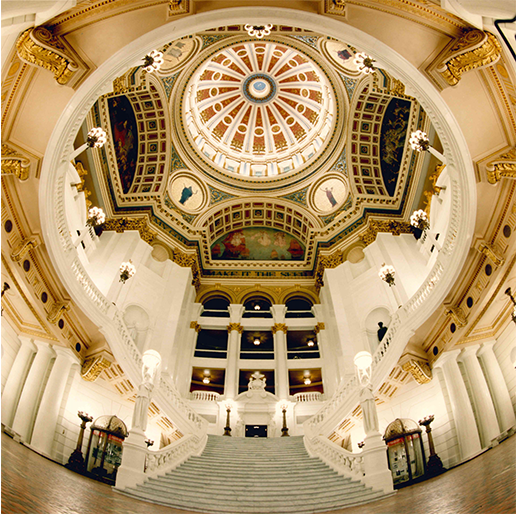
ROTUNDA
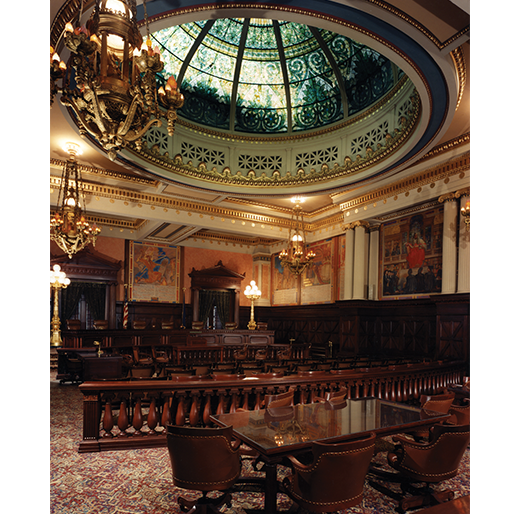
SUPREME COURT ROOM
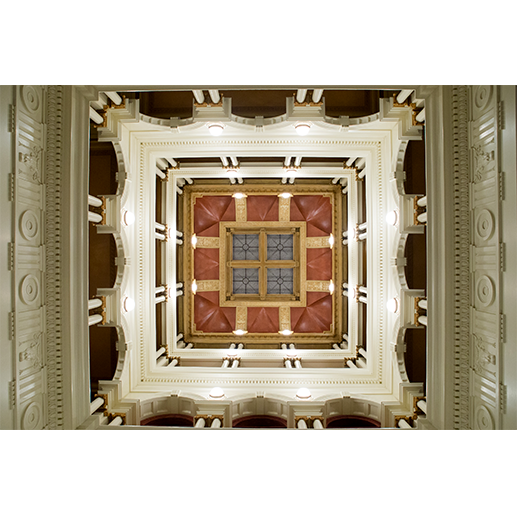
SKYLIGHTS
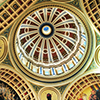
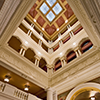
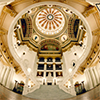
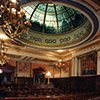
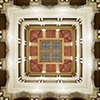
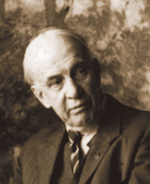 William B. Van Ingen was born in Philadelphia and studied at the Pennsylvania Academy of the Fine Arts as a pupil of Thomas Eakins and Christian Schuessele. After completing his studies at the Academy, he moved to New York where he apprenticed under three noted stained glass artists: John La Farge, Francis Lathrop, and Lewis C. Tiffany.
William B. Van Ingen was born in Philadelphia and studied at the Pennsylvania Academy of the Fine Arts as a pupil of Thomas Eakins and Christian Schuessele. After completing his studies at the Academy, he moved to New York where he apprenticed under three noted stained glass artists: John La Farge, Francis Lathrop, and Lewis C. Tiffany.
In addition to his talent in stained glass, Van Ingen was also a noted and prolific muralist. He was best known in artistic circles for his commission by the U.S. Government to paint murals in the Panama Canal Administration Building. The five murals, which were installed in 1915, comprise an area of 1,000 square feet and illustrate different phases in the canal's construction. Van Ingen was selected to paint the murals at the request of canal builder Major Gen. George R. Goethals. He also received commissions to paint murals in the Library of Congress in Washington, D.C., Pennsylvania State Capitol in Harrisburg, New Jersey State Capitol in Trenton, U.S. Mint in Philadelphia, and Federal buildings in Chicago and Indianapolis.
Van Ingen was awarded the Pennsylvania State Capitol commission in 1902, and chose to represent Pennsylvania's religious development through fourteen painted murals that reside in the lunette spaces of the Capitol's first floor along the south corridor. He also designed the twenty-four circular opalescent stained glass windows located in the House and Senate Chambers. These incredible works of art symbolize the history, art, science, and industry of Pennsylvania.
After receiving a commission from financier Charles T. Yerkes to make a Japanese room for his New York residence, Van Ingen visited Japan and made extensive studies in Japanese art. He also painted murals for private residences in Philadelphia.
During 1937-1938, under a Depression-era grant from the federal government's Works Projects Administration, Van Ingen created over 4,500 square feet of murals for the University at Albany in Hawley Hall.
Although best known for his artistic accomplishments, Van Ingen was also a strong advocate of preserving New York's public parklands. He lectured and wrote on the topic and served as chairman of the parks committee of the New York Grand Jurors Association.
Van Ingen spent the latter part of his life at the Masonic Home in Utica, New York, where he died after a long illness on February 6, 1955, at age ninety-six.
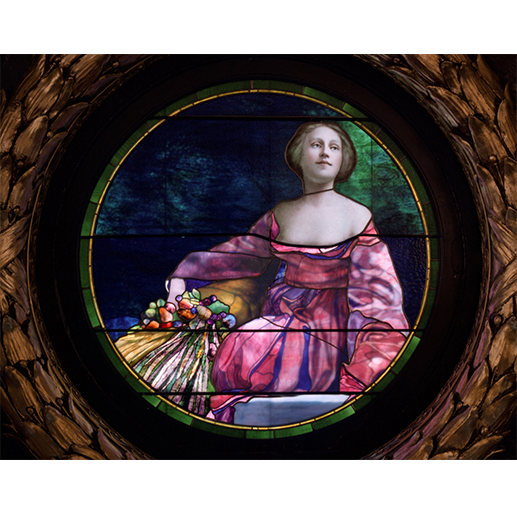
ABUNDANCE

COMMERCE
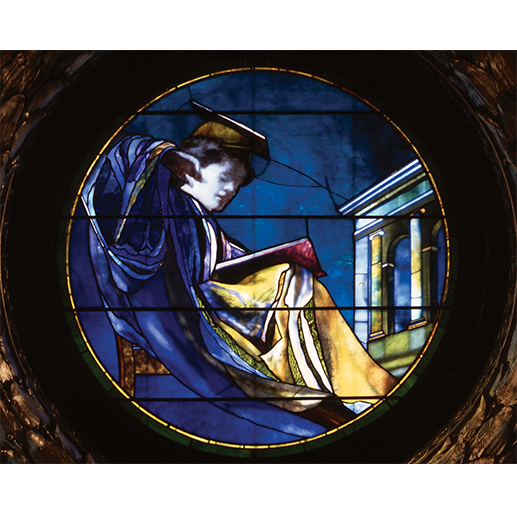
EDUCATION
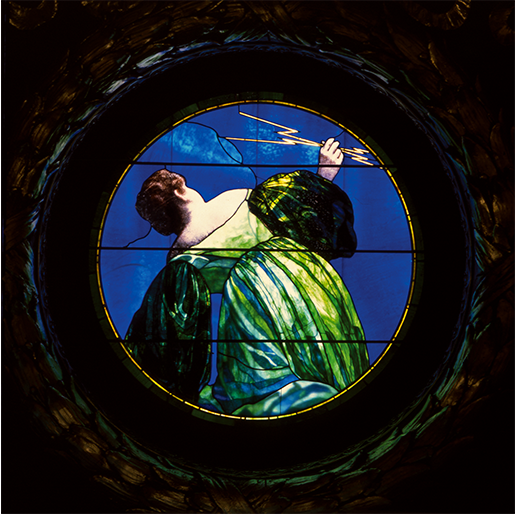
ELECTRICITY
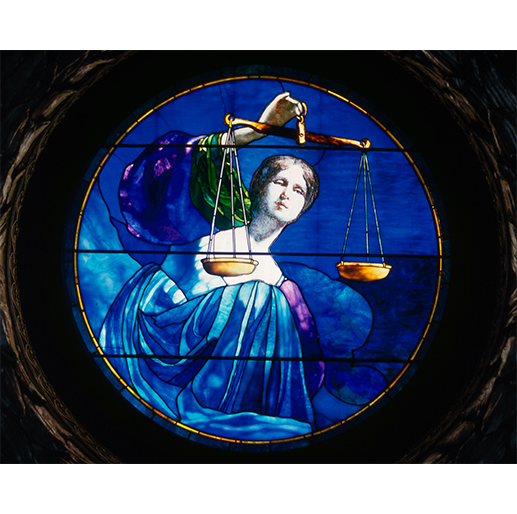
JUSTICE
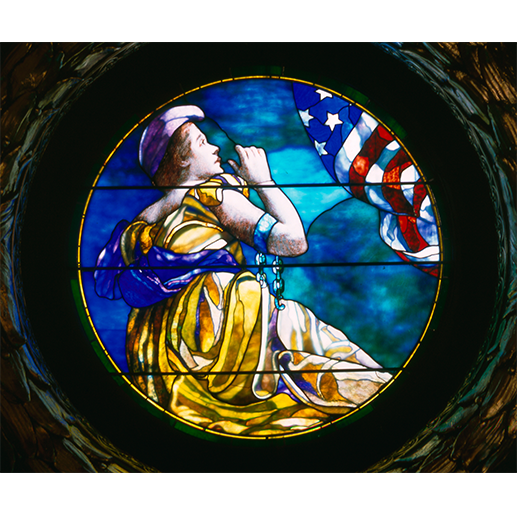
LIBERTY

MILITIA
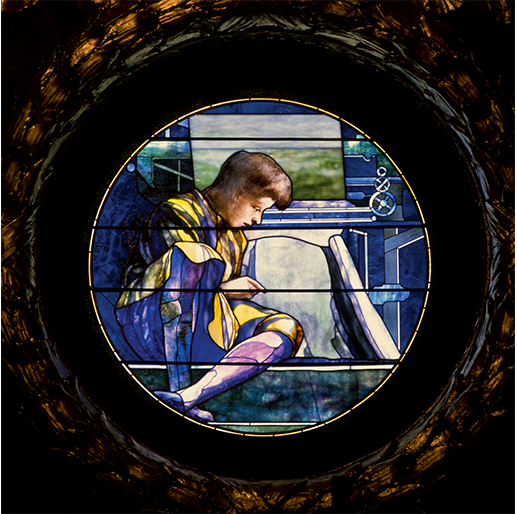
PRINTING PRESS
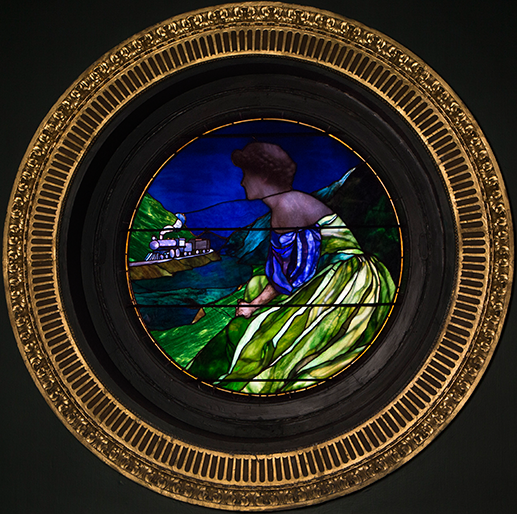
RAILROADS
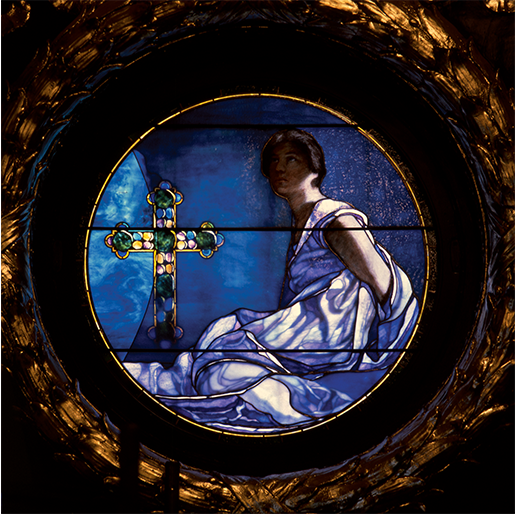
RELIGION
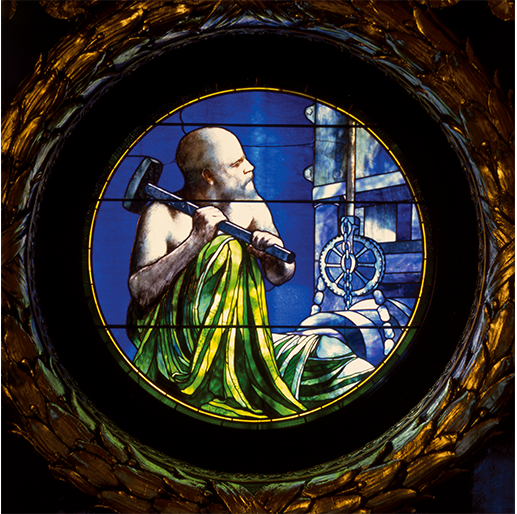
STEEL AND IRON
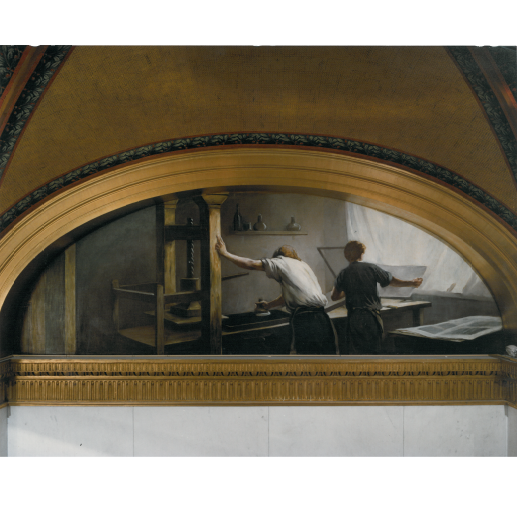
PRINTING OF THE BIBLE ON THE SAUR PRESS AT GERMANTOWN PRESS

MORAVIAN SISTER PREACHING TO THE INDIANS
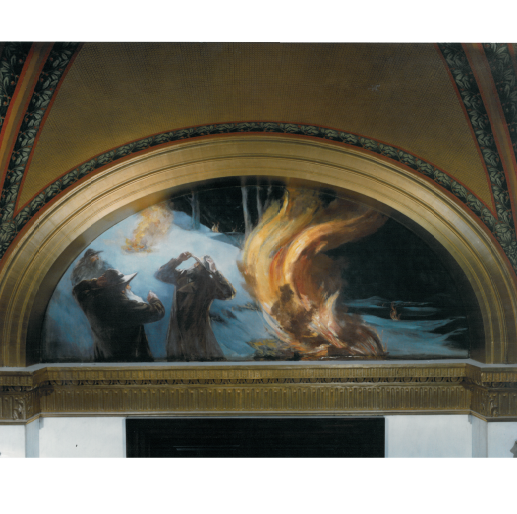
BONFIRES LIT BY EARLY SETTLERS ON CHRISTMAS EVE
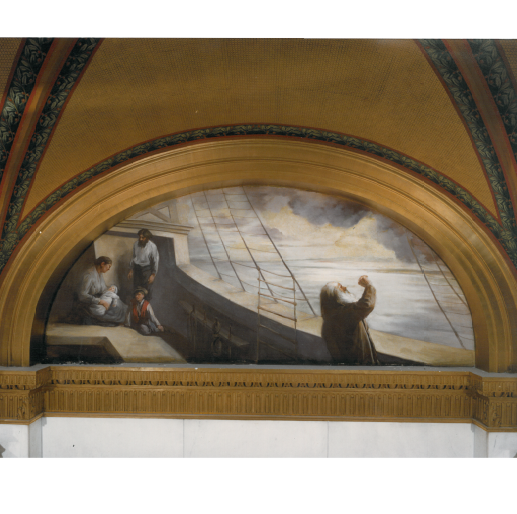
GERMAN IMMIGRANTS FROM THE PALANTINE ON THE SARAH MARIA
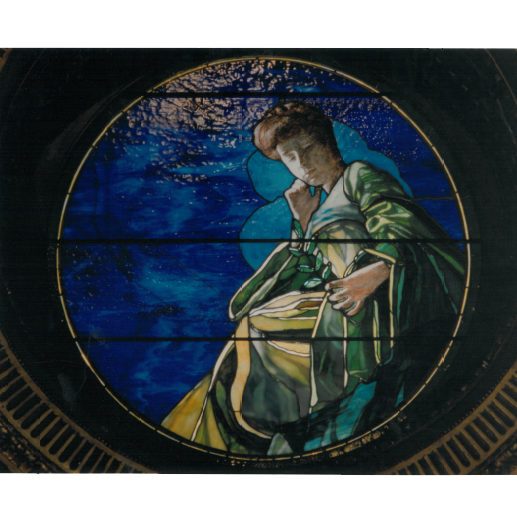
PEACE
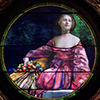
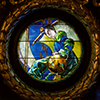
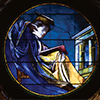
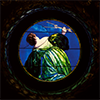
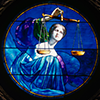
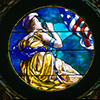
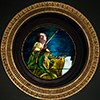
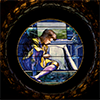
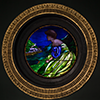
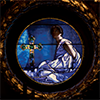
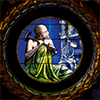
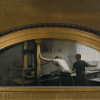
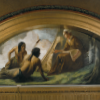


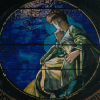
Henry Chapman Mercer was born in Doylestown, Pennsylvania and attended Harvard University and the University of Pennsylvania Law School. Though he worked as a lawyer for a time, he later gave up the practice in favor of archaeology. In the early 1890s he was appointed Curator of American and Prehistoric Archeology at the University of Pennsylvania’s Museum.
A turning point in his life came in 1897 when Mercer became concerned with the destruction of early American society, which he saw being replaced by industrialism. Seeing a jumble of old agricultural tools and household utensils for sale, he realized very quickly that American pre-industrial history was being displaced. Mercer abandoned his job at the museum and began "rummaging the bake ovens, wagon houses, cellars, haylofts, smokehouses, garrets, and chimney corners" for what would later be known as Americana. Mercer collected all kinds of American artifacts and tools from hoes and forks to plows and pottery.
In 1913 he began work on a museum to house his growing collection of more than twenty-five thousand objects. As part of his collecting, Mercer became interested in the pottery of Pennsylvania Germans. Concerned that this craft was dying out, Mercer apprenticed himself to one of the few authentic potters in upper Bucks County to learn all about clays, glazes, and kilns. In 1899 Mercer built the Moravian Pottery and Tile Works, which still operates in Doylestown today. The first tiles he produced were based on early German stove plates, which Mercer himself had collected.
By 1900 Mercer was becoming an important artisan who was influenced by the Arts and Crafts movement in America. No doubt aware of the building contracts being sought for the State Capitol in 1902, Mercer made a point to suggest the idea to architect Joseph Huston of folk-art tile for the building’s floor. He said that his tile would better harmonize with the white marble Capitol walls, than the original marble floor that Huston had envisioned in his designs for the Capitol’s first floor. Huston accepted the idea of allowing both folk and fine art to coexist in the Capitol building, proving that he was interested in this art form.
Mercer decided that he would trace the history of the Commonwealth from prehistoric times to 1906 using mosaics grouted into the floor. Huston approved the concept, and Mercer went on to produce 368 mosaics. They were installed beginning at the Capitol’s north wing entrance, and continued chronologically through the building until ending at the south wing entrance. The result is the largest piece of artwork in the Capitol. In all, Mercer would produce thousands of clay field tiles for the floor of the Capitol — the most of any building containing his tiles. For the sixteen thousand square feet of tile, the Commonwealth was billed three dollars per square foot.
Though the Capitol is the largest single collection of Mercer’s tiles, it may not be the most famous. The casino at Monte Carlo, Rockefeller’s New York estate in Pocantico Hills, and Grauman’s Chinese Theater in Hollywood all boast Mercer tiles in quantity. After the completion of the Capitol commission, Mercer went on to build his own unique house called Fonthill, located adjacent to his tile works in Doylestown. The innovation of this domestic structure lay in Mercer’s use of reinforced concrete. Although reinforced concrete was commonly used for industrial buildings (Mercer had already utilized this kind of concrete for his tile factory and his museum), it was an unusual building material for a house. Reinforced concrete, coarse-textured and unconcealed, covers both the exterior and interior of Fonthill. Mercer was one of the first artists in the United States to recognize the aesthetic value of exposed concrete for a modern structure. He also built his own museum to house the artifacts of Americana that he had collected. Today the Mercer Museum is home to over forty thousand artifacts of early American society.
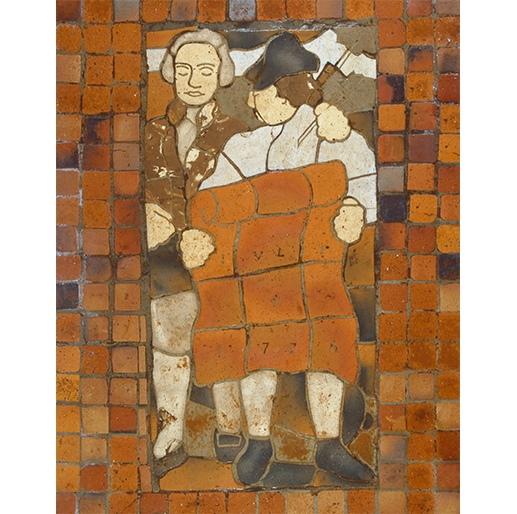
READING OF THE DECLARATION OF INDEPENDENCE
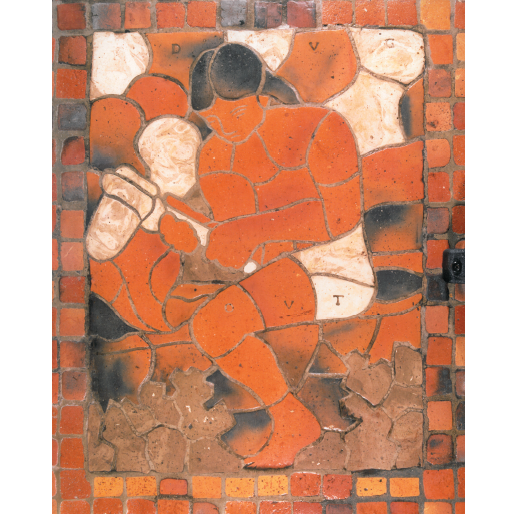
INDIAN MAKING A DUGOUT CANOE

MILKING THE COW
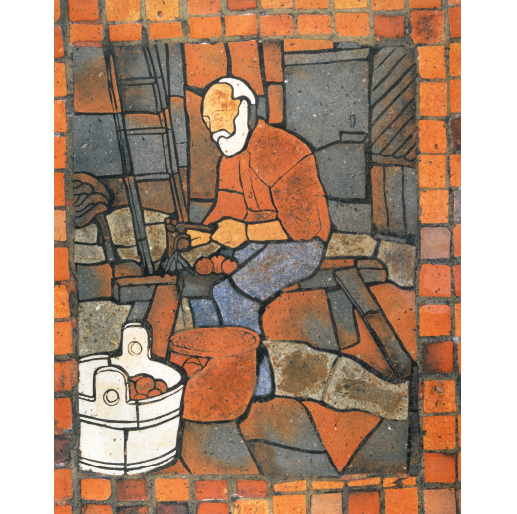
PAIRING APPLES
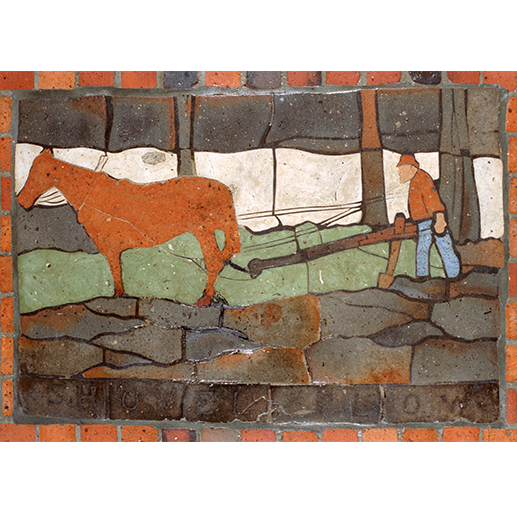
PLOWING WITH SHOVEL PLOW
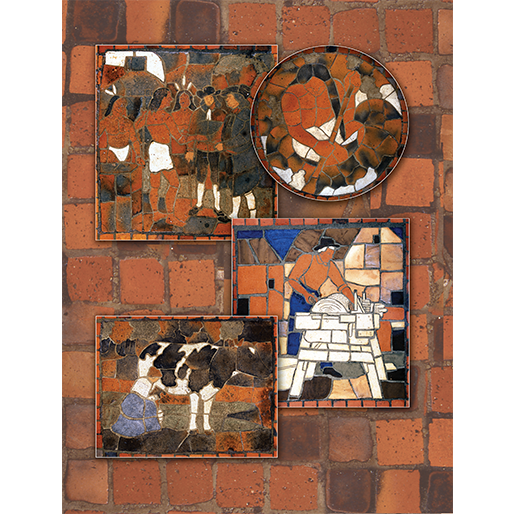
WORKERS
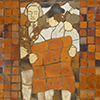
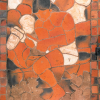
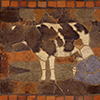
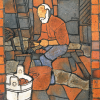
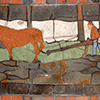
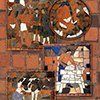
Edwin Austin Abbey was one of the most celebrated illustrative artists of his day. Born in Philadelphia, he briefly studied art at the Pennsylvania Academy under Christian Schuessele. Before he was twenty years old, he was enjoying a brilliant career as an illustrator of poetry and drama for Harper's Weekly. Then in the late 1870s, Abbey left America for England to pursue a career as a large-scale history painter. While in England, he was elected to the Royal Academy and admitted to the elite artistic circle of the Pre-Raphaelites.
As a result of his growing reputation at home and abroad, Abbey was about to undertake what would become his most famous commission. He was invited by American sculptor Auguste Saint-Gaudens in 1890 to produce the mural cycle The Quest for the Holy Grail for the McKim, Mead, and White Boston Public Library, which was completed in 1901.
When Abbey was given his largest commission in 1902 to decorate the House and Senate Chambers, the Supreme and Superior Court Room, and rotunda in the Pennsylvania Capitol, the artist knew that this monumental project inaugurated a new phase in his career. Thus, he turned all of his energies to this project that he saw as his personal tribute to Pennsylvania and its history.
Abbey executed the Capitol murals in his studio in England. By the spring of 1908, all murals for the rotunda were complete. They were exhibited at the University of London, where they received the highest acclaim. King Edward VII himself expressed regret that these magnificent paintings were leaving England. By 1909 the murals for the Capitol rotunda had been shipped to Harrisburg and were placed at the collar of the dome. Four large circular canvases, 14 feet in circumference, were installed in the pendentives. The four huge crescent-shaped murals, measuring 38 feet by 22 feet, were placed in the lunettes of the rotunda.
When Abbey died suddenly in 1911, his widow administered the completion and installation of the House murals. The artist had completed three works for the House: The Apotheosis of Pennsylvania, Penn's Treaty, and The Hours, the latter of which is located on the ceiling. The Reading of the Declaration of Independence for the House Chamber had been partially completed. This painting was finished by Ernest Board, a member of Abbey's studio, under the supervision of John Singer Sargent, a close personal friend and neighbor. Only one mural had been executed for the Senate chamber entitled The Camp of the American Army at Valley Forge, February 1778. This painting, completed in 1910, had originally been placed in the Senate Chamber. As a result of Abbey's untimely death, it was removed and relocated onto a north wall in the rear of the House Chamber where it remains today.
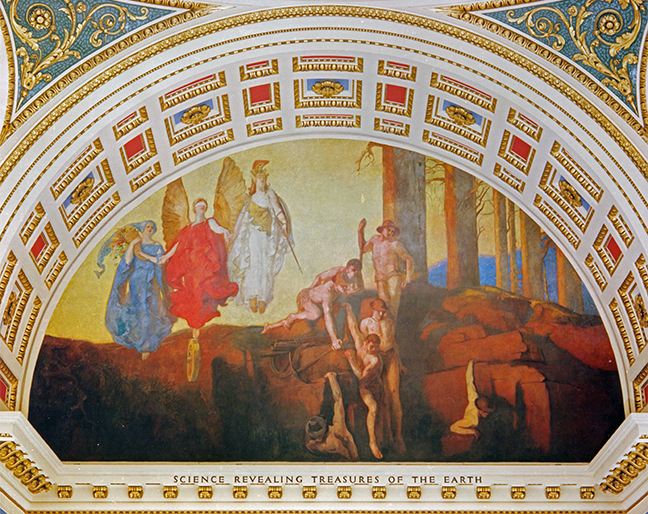
SCIENCE REVEALING TREASURES OF EARTH
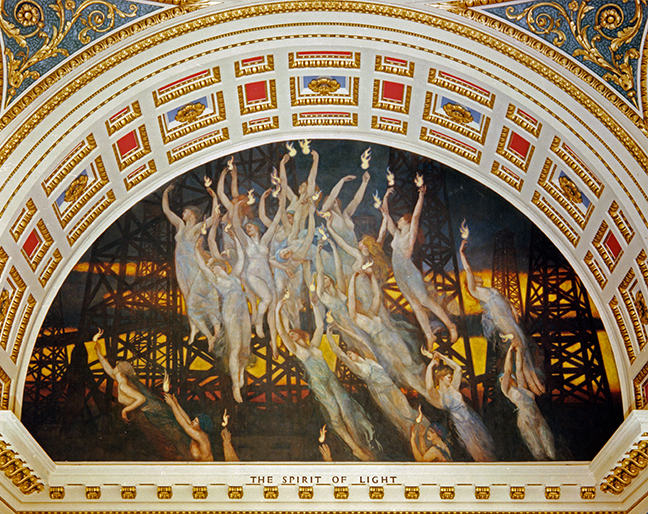
THE SPIRIT OF LIGHT
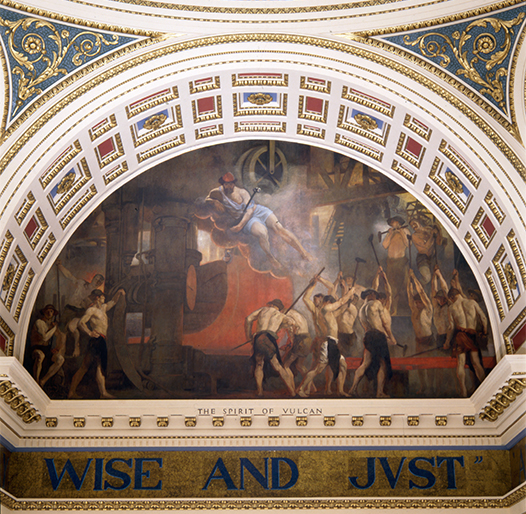
THE SPIRIT OF VULCAN

THE HOURS
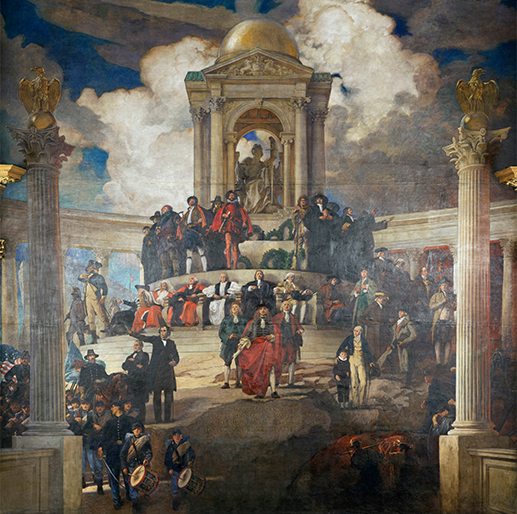
THE APOTHEOSIS OF PENNSYLVANIA

THE CAMP OF THE AMERICAN ARMY AT VALLEY FORGE, FEBRUARY 1778
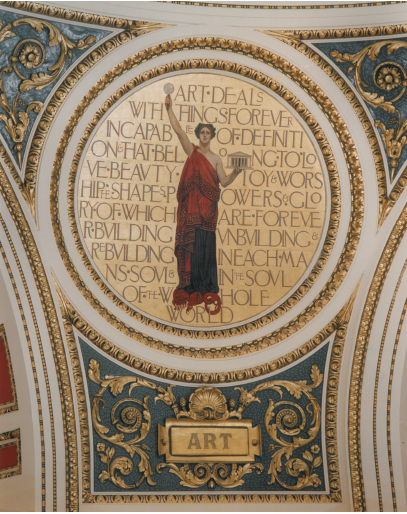
ARTS DEALS WITH
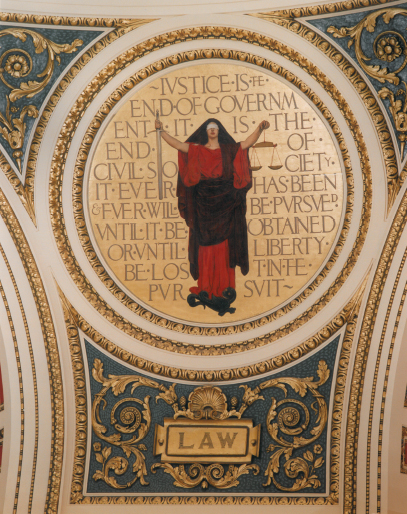
LAW

RELIGION

SCIENCE
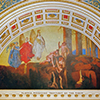
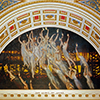
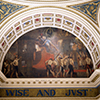
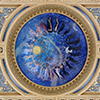
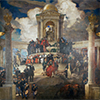
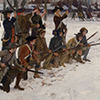

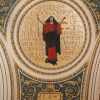

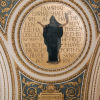
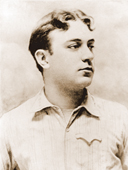 Artist Roland Hinton Perry is the man who sculpted the statue Commonwealth on top of the Capitol's dome. Often referred to incorrectly as Ms. Penn, Commonwealth is the most visible piece of Capitol artwork as she can be seen from miles around Harrisburg. Perry was commissioned by Joseph Huston in 1904 to execute a drawing that the architect had done of this allegorical figure.
Artist Roland Hinton Perry is the man who sculpted the statue Commonwealth on top of the Capitol's dome. Often referred to incorrectly as Ms. Penn, Commonwealth is the most visible piece of Capitol artwork as she can be seen from miles around Harrisburg. Perry was commissioned by Joseph Huston in 1904 to execute a drawing that the architect had done of this allegorical figure.
Using a series of steam hoists, the bronze figure was lifted to the top on the dome and installed on May 25, 1905. According to Huston, she represents "the symbolic embodiment of the Commonwealth of Pennsylvania." The statue weighs three tons and the figure alone stands fourteen-feet-six-inches tall. Adding the large gilded ball at the base, the entire sculpture stands over eighteen feet high.
Perry was a master of both painting and sculpture, and he began his studies at the Art Students' League in New York City at the age of sixteen. Three years later he traveled to Paris to study with Paul Delance at the Academie Delecluse. He entered the École des Beaux-Arts in 1890 as the only American student admitted that year. Perry remained in Paris for six years, producing both paintings and sculpture.
Returning to the United States, he was commissioned to sculpt bas reliefs at the Library of Congress. He also created a frieze for the New Amsterdam Theater in New York City. Perry is also credited with two monuments at Gettysburg National Military Park — the statue of Brigadier General George Greene on Culp's Hill, and Brigadier General James Wadsworth on McPherson's Ridge. In all, Perry designed and created over thirty major pieces of art, and he continued to work prolifically until his death on October 27, 1941.
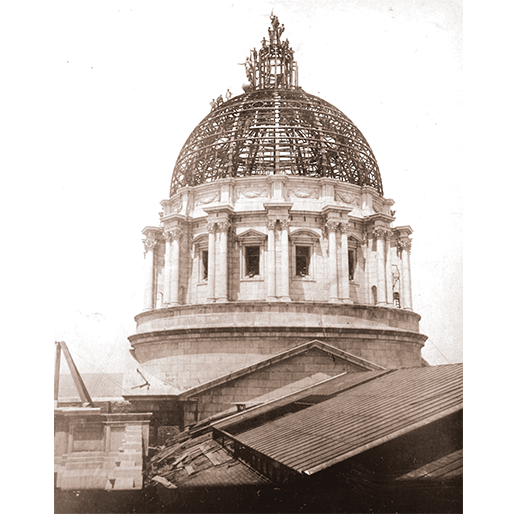
COMMONWEALTH ATOP CAPITOL DOME

COMMONWEALTH
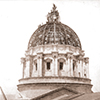
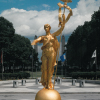
George Grey Barnard was born in Bellefonte, Pennsylvania in 1863. Though by birthright a native of Pennsylvania, his family moved west eventually settling in Illinois when he was only three years old. From childhood Barnard manifested a determination and an aptitude for creating form with his hands. He worked as a taxidermist and later an engraver before entering the Art Institute of Chicago when he was nineteen. At the Institute, Barnard became enamored with the works of Italian master Michelangelo who he emulated throughout his lifetime. After his studies in Chicago, Barnard had made enough money from sculpting to travel to Paris to engage in advanced training. In Paris, Barnard was admitted to the prestigious École des Beaux-Arts for a three-year term of study. He truly lived the Bohemian lifestyle of an artist — reclusive, often penniless, and totally devoted to his art.
His first large commission came from Alfred Corning Clark of the Singer Manufacturing Company. Clark's commission was for the famous The Two Natures of Man, now in the collection of the Metropolitan Museum of Art in New York City. Lauded for this creation, Barnard was relegated to financial hardship after the death of his patron in 1896. While he had several commissions that allowed him artistic survival, it was Joseph Huston's 1902 Capitol commission that again propelled Barnard to the forefront of the sculpting world. The original sculptural commission for Barnard was much larger than what was actually produced for the building — another unfortunate side effect of monetary cutbacks in the construction costs. The original commission called for six sculptural groups, each to be situated on pedestals at all three of the Capitol's west entrances.
Barnard set out immediately sketching and creating small models of his sculpture in clay. As soon as the first of these models was complete — those for the main entrance — Barnard set off for France to begin the creation of the twenty-seven heroic figures. During his time in Moret, Barnard began collecting artwork from the Middle Ages in France as well as Gothic and Romanesque period pieces from his European travels. However, he often said he was no artist when it came to financial matters and, accordingly, it was widely known that he lived a bit beyond his means. To supplement his income, he was later forced to sell portions of his vast collection to wealthy American patrons to help pay for his workers and the marble casts of the Capitol groups. In 1904 the original sculptural scheme along with other artwork within the building was scaled back, which allowed Barnard to focus on completion of the two groups for the main entrance. Barnard completed these two groups in 1910. They were titled Love and Labor: The Unbroken Law—the north group, and The Burden of Life: The Broken Law—the south group, respectively.
The rough carving of these groups was done by the famed Piccirilli Brothers, a highly talented family of artists, many of whom had emigrated from Italy to New York City. The Piccirillis were also contracted to install the statues in 1911, inspect them for damage in 1928, and clean them in 1935. George Grey Barnard's finished groups were exhibited at the Paris Salon with praise from his contemporaries such as Auguste Rodin. President Roosevelt was returning from one of his African safaris and just happened to be in attendance at the Paris Salon. Upon seeing the statues he remarked that they were "ideal for a capitol." After their exhibition, the groups were disassembled and shipped to Harrisburg. Installed on October 4, 1911 — a day that the legislature designated "Barnard Day" — the magnificent marble groups were dedicated in front of a crowd of five thousand people. Notable dignitaries included former Governors James A. Beaver and Samuel W. Pennypacker, and artist Violet Oakley.
In 1917 Barnard produced a massive head of Abraham Lincoln that he called Lincoln in Thought. During this time Barnard continued his collecting of Romanesque and Gothic works of art and assembled a massive collection at his "Cloisters" museum in Washington Heights, New York, which he opened to the public in 1914. (Purchased by John D. Rockefeller Jr. in 1925, today it is a branch of the Metropolitan Museum of Art.) Barnard completed numerous other works of sculpture such as The God Pan located at Columbia University, The Hewer in Cairo, Illinois, and Rising Woman and Adam and Eve for the Rockefeller estate at Pocantico Hills, New York. He was at work on a massive project called the Rainbow Arch when he passed away in 1938. At his request, his body was moved to Harrisburg and he was buried in Harrisburg Cemetery, to be close to the Capitol statuary, which he considered to be his masterpiece.

GEORGE GREY SELF PROTRAIT

PICCIRILLI BROTHERS CARVING THE BARNARD STATUARY, CA. 1907
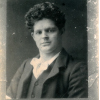

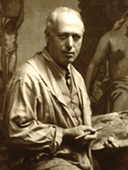 Originally, John White Alexander of Pittsburgh was commissioned to paint the murals for the Capitol's north hyphen lunettes, opposite those of William Van Ingen. However, Alexander said that he was both too busy and too ill at the time to accept the commission.
Originally, John White Alexander of Pittsburgh was commissioned to paint the murals for the Capitol's north hyphen lunettes, opposite those of William Van Ingen. However, Alexander said that he was both too busy and too ill at the time to accept the commission.
The lunettes in the north hyphen were actually left undecorated until artist Vincent Maragliotti was offered the commission in 1970. Completed in 1973, Maragliotti chose to depict scenes of Pennsylvania's commercial and transportation history with the murals — the original theme designated by architect Joseph Huston.
A native of Italy, Maragliotti emigrated to the United States at age seventeen. He studied architecture and fine arts at the National Academy of Design and the Cooper Union Art College in New York. He later relocated to Pennsylvania after receiving his first commission for the Commonwealth to paint the ceiling murals in the main entrance lobby of the Education Building, which was completed in 1934. He purchased property in New Buffalo, Perry County and later moved to Summerdale to be closer to Harrisburg.
Maragliotti continued his work within the Capitol Complex, receiving a commission to produce ceiling murals for the main entrance lobby of the Finance Building from 1938-1939. In 1964 he completed a massive mural for the William Penn Memorial Building. Although untitled, this work was based on the theme "William Penn's vision of a free society and what came out of it." This massive mural, which has a frescoed quality to it, was installed in six separate sections on the second floor of the Pennsylvania State Museum. The total cost of the painting was more than $115,000.
Maragliotti was also noted for his decorative work in hotels and theaters throughout the east coast. He painted murals in the Copley Plaza Hotel in Boston, the Waldorf-Astoria and Biltmore Hotels, and the Strand, Roxy, Majestic, and Shubert theaters in New York City.

JOHN FITCH'S STEAMBOAT
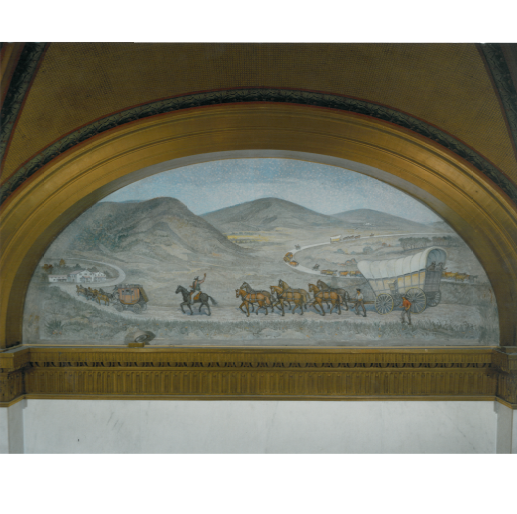
TURNPIKE BOOM CONESTOGA WAGON

RAILROADS AND TELEGRAPH
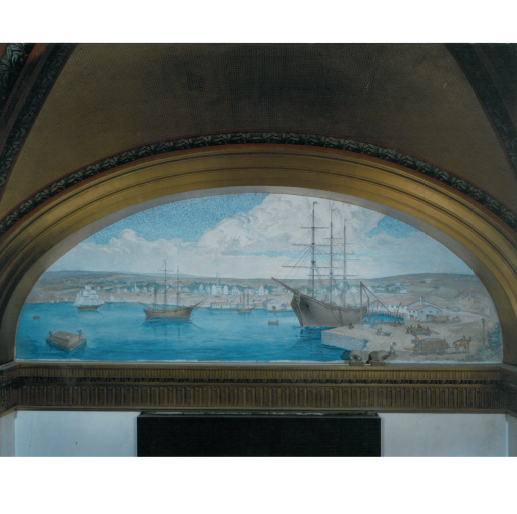
PHILADELPHIA COMMERCE
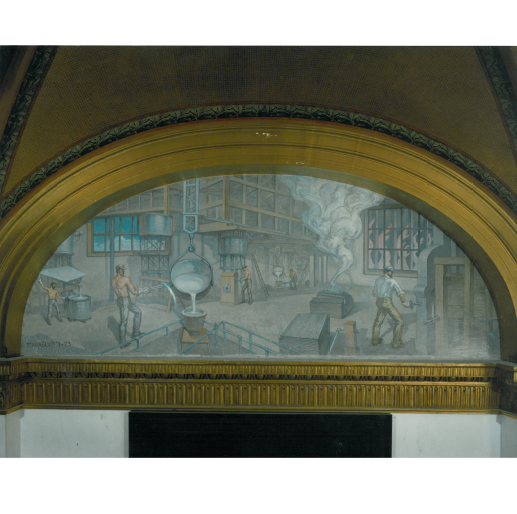
STEEL
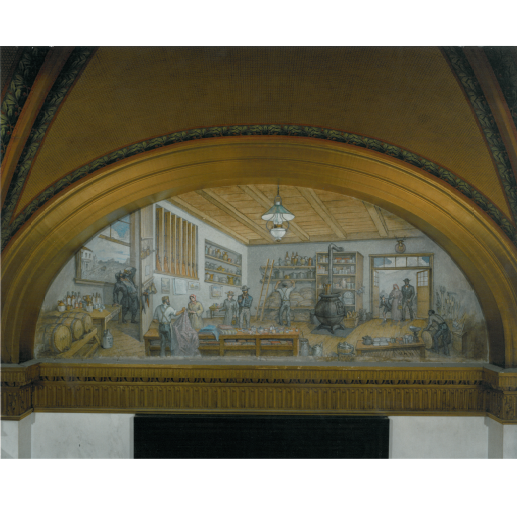
COUNTRY STORE
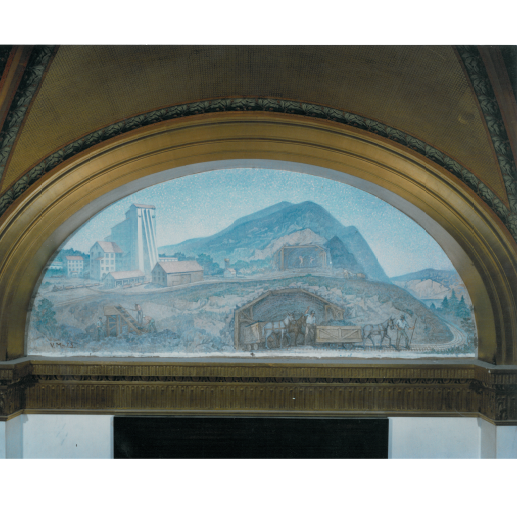
COAL

LUMBER
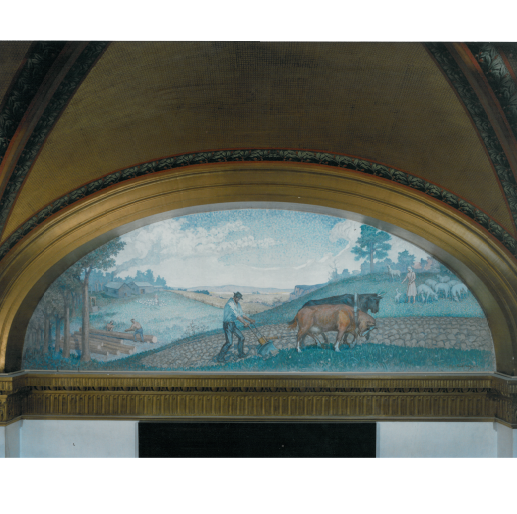
AMISH FARMING

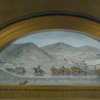

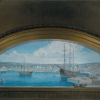
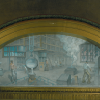

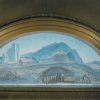
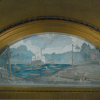
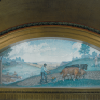
In 1902 Violet Oakley was the first woman artist to receive a large commission for adorning a capitol building in the United States. Though it was not known at the time, Oakley would become the principal artist for the largest amount of murals in the Pennsylvania Capitol. Through the assistance of a mutual friend of hers and Joseph Huston's, architect John Irwin Bright, she was recommended as an artist for the building. Huston offered Oakley the commission to paint murals for the Governor's Reception Room because he felt it would "add interest to the building and act as an encouragement of women of the state."
Oakley was actually born in Jersey City, New Jersey, though she lived the majority of her life in Philadelphia. She studied at the Art Students' League in New York and later at Drexel with famous illustrator Howard Pyle. Oakley became part one of a triumvirate of three noted female illustrators of their time — Oakley, Elizabeth Shippen Green, and Jessie Wilcox Smith. From 1902 until 1906 these three illustrators lived together at the Red Rose Inn in Villanova, Pennsylvania, which was where Violet started her murals for the Governor's Reception Room, a frieze that she titled The Founding of the State of Liberty Spiritual.
Traveling to England, Oakley immediately set out to conduct research for her murals. Though both Governor Pennypacker and Huston gave her recommendations on topics for the room, Oakley persisted in depicting the story of William Penn, as the founder of the colony. Violet was very strong in her conviction about wanting to trace Pennsylvania's history of religious tolerance and the ideals of social freedom and justice inherited from Penn for the reception room murals. Eventually, both Huston and Governor Stone acquiesced to her designs after they reviewed her preliminary studies that were presented before the Capitol Building Commission.
When the frieze was complete in 1906, Oakley's fourteen murals for the reception room were some of the first to be installed in the Capitol. Though they were sent to Harrisburg prior to the October 4 dedication, they were not yet in place due to finishing touches in the reception room. The thirteen murals were unveiled on November 27, 1906 before a large crowd.
With her work complete, Oakley found other commissions to occupy her time, but with the passing of Edwin Austin Abbey in 1911, Samuel B. Rambo, Superintendent of Public Grounds and Buildings, offered Oakley the opportunity to create murals for the Capitol's unfinished Senate and Supreme Court Chambers. She began her new contract in 1912 working on both commissions concurrently, although the Senate took precedence. After more research and work, the Senate murals on the front wall, Unity and The Creation and Preservation of the Union, were dedicated on February 12, 1917. The two Quaker legends at the back of the Chamber were dedicated on January 20, 1919.
After the completion of the Senate murals, Violet devoted her attention to the Supreme Court Chamber, and for these paintings she chose to illustrate what she saw as the evolution of law, from its earliest beginnings to the present. These murals are Violet's most allegorical and they also best illustrate her ideological journey as a painter committed to the ideals of world peace. She chose to represent law as movement up a musical scale, beginning with the painting Divine Law, which she said was both the Alpha and the Omega. The frieze continues around the room proceeding from the paintings The Law of Nature and International Law, before returning to the Keynote. Violet fervently believed that her vision of the evolution of law, as depicted in the Supreme Court Chamber, would lead to eventual world peace. The murals in the court chamber were installed and dedicated on May 23, 1927. Overall, Violet Oakley is the only artist to work over a quarter century decorating the building, creating forty-three murals for the Capitol.
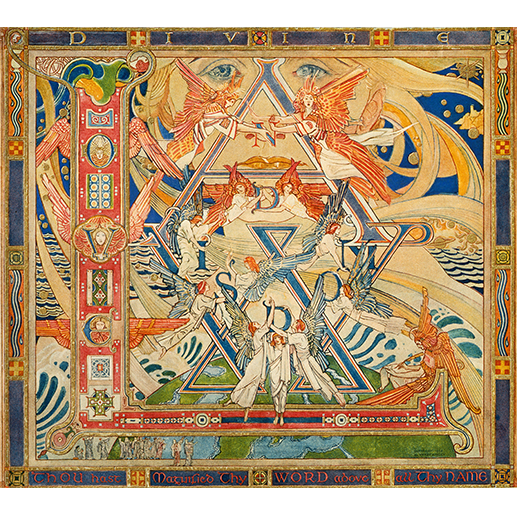
DIVINE LAW
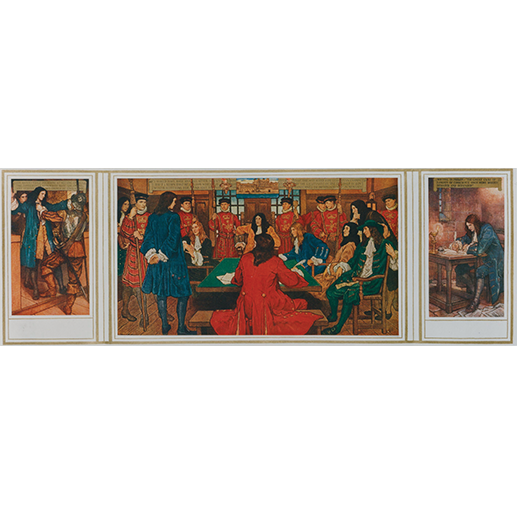
EXAMINATION BEFORE THE LIEUTENANT OF THE TOWER OF LONDON
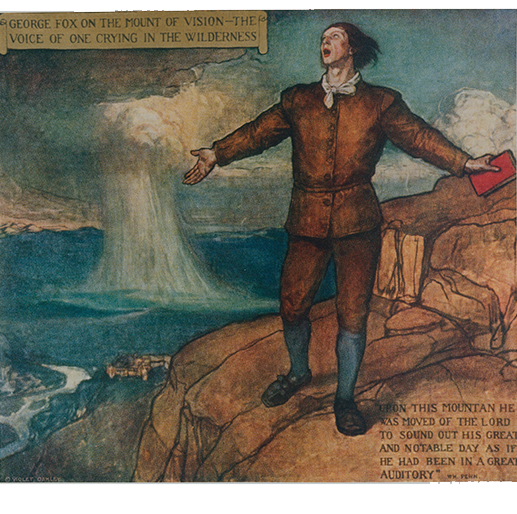
GEORGE FOX ON MT. VISION
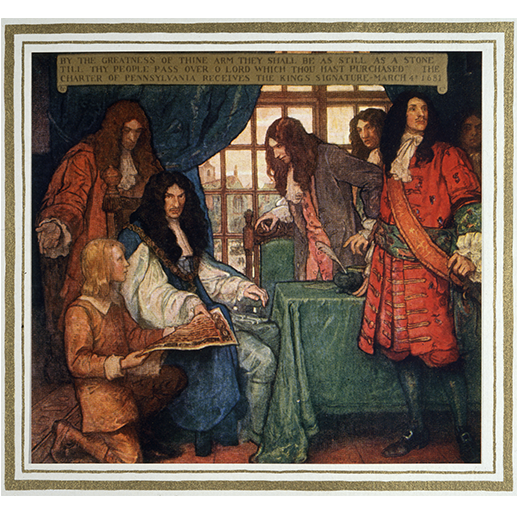
KING CHARLES SIGNING THE CHARTER
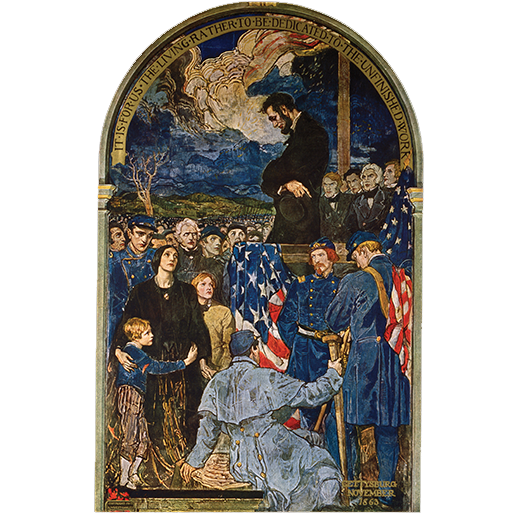
LINCOLN AT GETTYSBURG
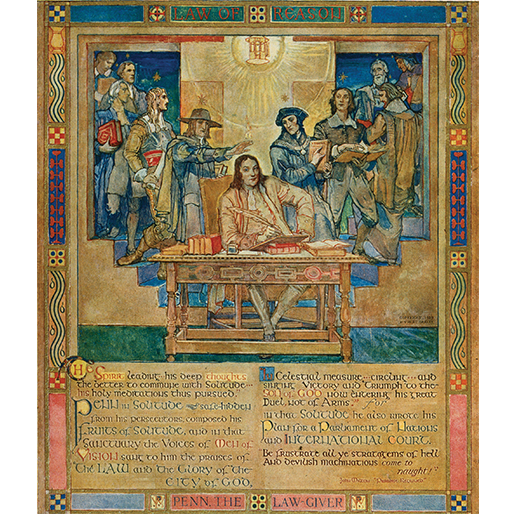
WILLIAM PENN AS A LAW GIVER – LAW REASON
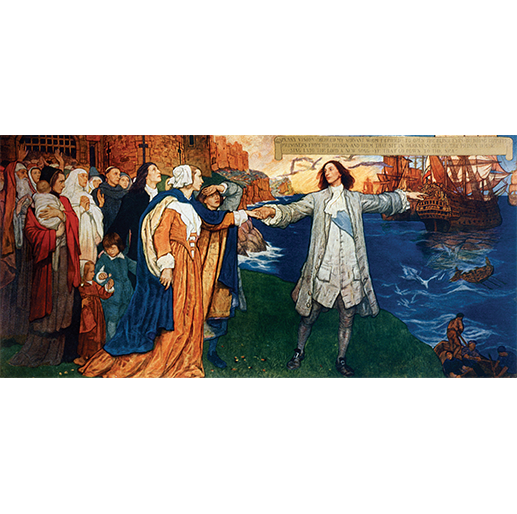
PENN'S VISION
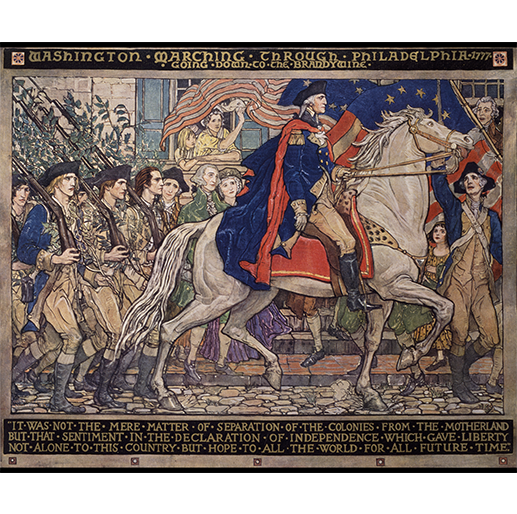
TROOPS OF THE REVOLUTION
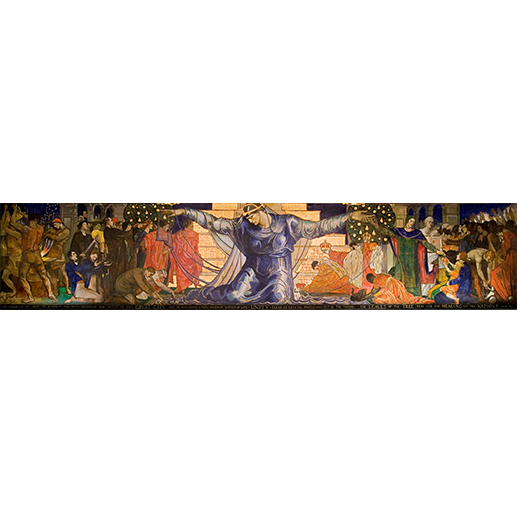
UNITY
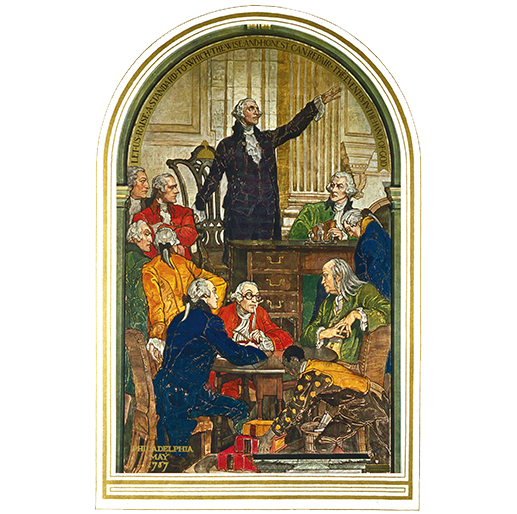
WASHINGTON AT THE CONSTITUTIONAL CONVENTION
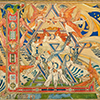
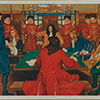
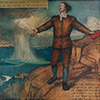

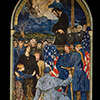
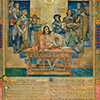
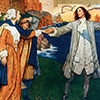
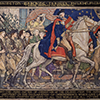
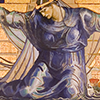
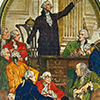
The exterior ornate bronze work for the Capitol building was contracted by the Henry-Bonnard Bronze Company of New York, under the supervision of bronze master Eugene F. Aucaigne. Architect Joseph Huston was introduced to Aucaigne through George Grey Barnard, who had contact with the company because they had produced his famous sculpture, The Hewer. After Huston had drawn the original sketches and studies, Henry-Bonnard, with Aucaigne at the helm, created the large bronze doors at the Capitol's west entrances, along with the monumental light standards topped with an eagle at the main entrance.
They also cast the majority of the large-scale ornate bronze work in the building. All the light standards on the first floor of the Capitol, the second floor rotunda balcony, the Senate and Supreme Court Chambers, and the Governor's Reception Room were produced by Bonnard. The House Chamber originally had standards also produced by the Henry-Bonnard firm, but these were removed as they took up too much space on the floor, hampering legislative activities. The second floor rotunda balcony grills at the post office areas, and the grills over the House and Senate entrance doors, along with the balustrade railings emblazoned with eagles on the fourth floor balcony, were also created by the Henry-Bonnard Company.
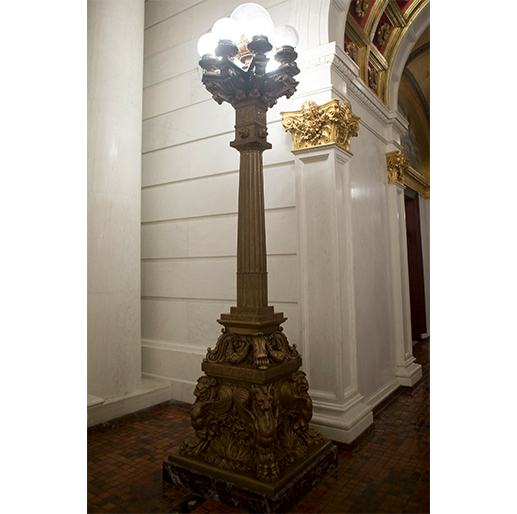
ROTUNDA LIGHT
The Pennsylvania Bronze Company was founded in Philadelphia in 1902 by John Sanderson in an effort to win the bronze contract for the Capitol building. It furnished all the ornate bronze light fixtures within the building, including the chandeliers and sconces in the House, Senate, and Supreme Court Chambers, the large lanterns at all three of the Capitol's west entrances, and the pumpkin ball fixtures throughout the building.
Many of the company's top craftsmen were former employees of the Sterling Bronze Company of New York City — a premier manufacturer of the finest cast and hand-chased fixtures. Several of the fixtures for the Capitol were gold plated, especially for ornate areas, such as the Governor's Reception Room and Lieutenant Governor's suite. Others were coated with a gold-tinted lacquer, a practice which is still commonplace.
The Capitol's ornate bronze fixtures are representative of the best bronze foundries of the day and do much to heighten the grandeur of the building.

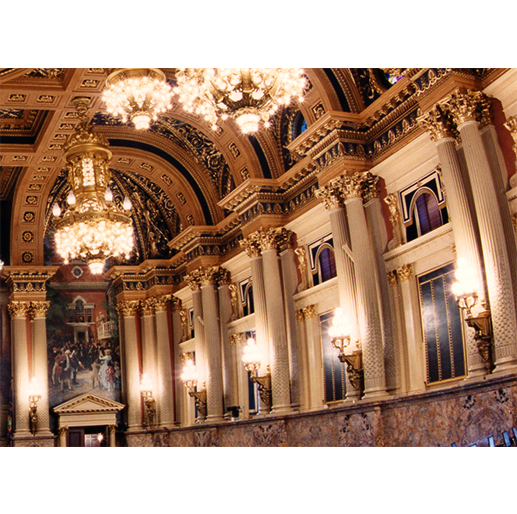
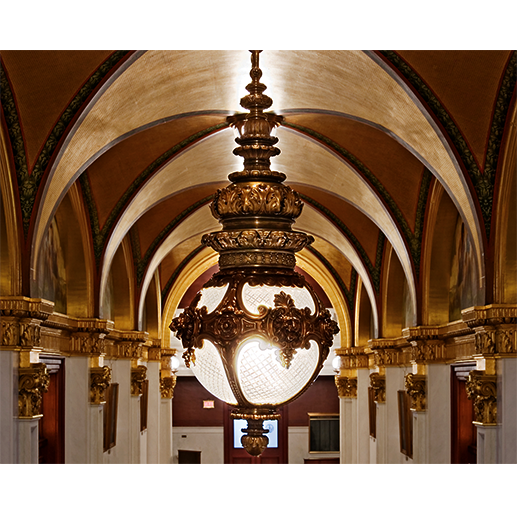
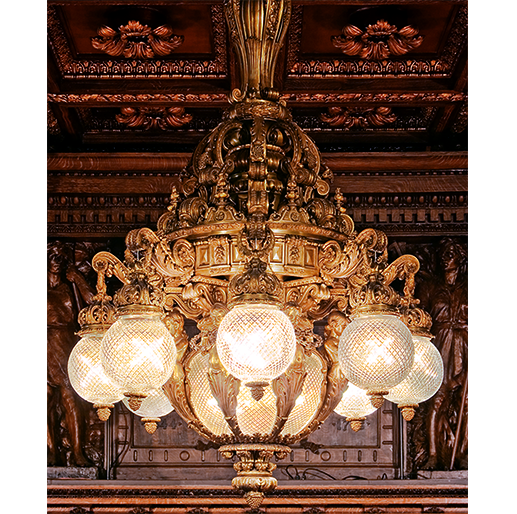
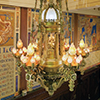
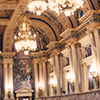
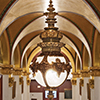
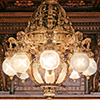
Vincent Alfano was a well-known artist who produced work for the Capitol building during its construction. Alfano was both a painter and a sculptor. A native of Naples, Italy, he had studied at the Academy of Naples under famous painters Domenico Morelli and Giuseppe Palizzi. He later became a professor of art at that Academy.
Alfano emigrated to America in 1898, attracted largely by commissions from the growing American Renaissance movement, which enticed numerous Italian artists. Alfano took up residence in New York and taught at the New York Industrial Museum. In 1902 he was given his Capitol commission, which was to execute sculptural groups for the two entranceways inside the building's main vestibule. The figures are allegorical representations located above the door pediments. The north group represents the early Commonwealth and its contact with Native Americans. The south group represents a Commonwealth enriched by arts and sciences. A theme of war and peace through which society has progressed are also espoused in both of the works.
From Joseph Huston's designs, Alfano also modeled the allegorical figures over the pediments at the second floor entrances to the House and Senate Chambers. The figures over the House represent "Truth" and "Justice," and those over the Senate "Legislature" and "Finance." The groups were inspired by Michelangelo's Medici Tombs for the New Sacristy in Florence, and similar motifs that were in the Paris Opera House. Alfano also carved the marble caryatids, globes, and cherubs located at the Entresol floor of the grand staircase, along with the sculpted plaster heads of famous Pennsylvanians present in the north and south hyphen corridors. In addition, the pediments over both the House and Senate Chamber's second floor entrances were produced by Alfano. The two large plaster Angels of Light gracing the newel posts of the grand staircase may also have been sculpted by Alfano, or possibly by a contemporary of his, Louis Milione of Philadelphia. Unfortunately, the original artist for these pieces remains unknown.
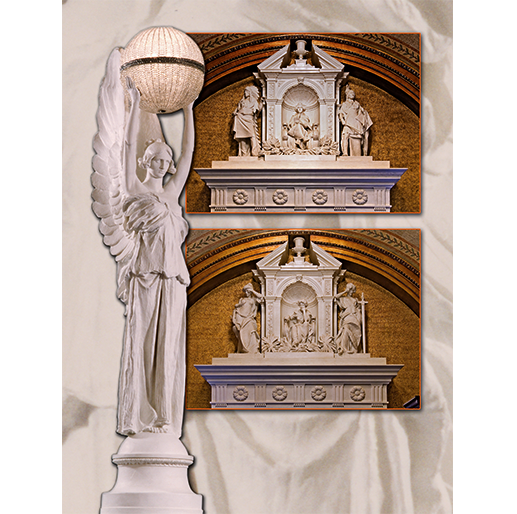
ANGEL OF LIGHT STATUE
The Pennsylvania Bronze Company was founded in Philadelphia in 1902 by John Sanderson in an effort to win the bronze contract for the Capitol building. It furnished all the ornate bronze light fixtures within the building, including the chandeliers and sconces in the House, Senate, and Supreme Court Chambers, the large lanterns at all three of the Capitol's west entrances, and the pumpkin ball fixtures throughout the building.
Many of the company's top craftsmen were former employees of the Sterling Bronze Company of New York City — a premier manufacturer of the finest cast and hand-chased fixtures. Several of the fixtures for the Capitol were gold plated, especially for ornate areas, such as the Governor's Reception Room and Lieutenant Governor's suite. Others were coated with a gold-tinted lacquer, a practice which is still commonplace.
The Capitol's ornate bronze fixtures are representative of the best bronze foundries of the day and do much to heighten the grandeur of the building.








Throughout the Capitol building there are many areas of ornate stenciling, Greek keys, acanthus designs, and elaborate decorative elements that were artistically a statement of Joseph Huston's American Renaissance design. While other artists dealt with the fine arts and specific Pennsylvania topics, the decorative elements in the building were contracted to the Donald R. MacGregor firm of Philadelphia.
Donald MacGregor (1870–1930), the principal in the firm, studied art at the Pennsylvania Academy of the Fine Arts under William Merritt Chase. He in turn completed several murals within the building. A notable mural, entitled Venus and Two Loves, was painted on the ceiling of a room in the Lieutenant Governor's office suite, which in 1906 served as the Ladies Reception Room.
Additional murals that MacGregor produced are located at the light court ends of each hyphen corridor, entitled the Four Seasons. In addition the painters on MacGregor's staff were responsible for all the gold and aluminum leafing, stenciling and glazing work, and highly ornate decorative painting throughout the building — a truly massive undertaking. Without the creative work of the MacGregor firm, the beauty of the Capitol would not be unified with its architectural surroundings. Their work is a blending of all of the building's elements, creating a harmony of art.
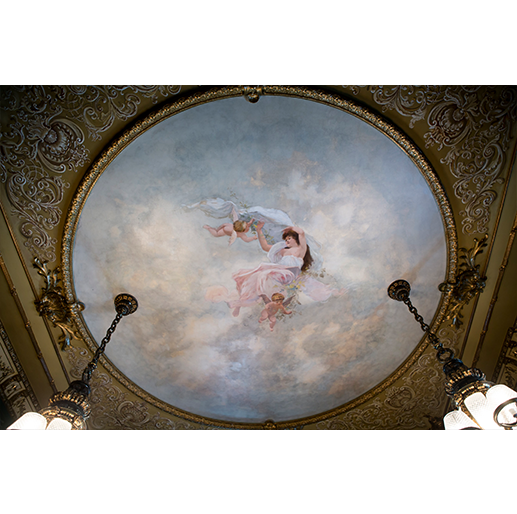
VENUS AND TWO LOVES
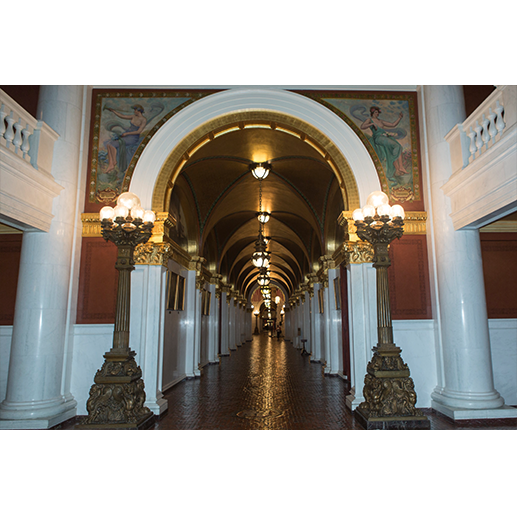
SPRING AND SUMMER
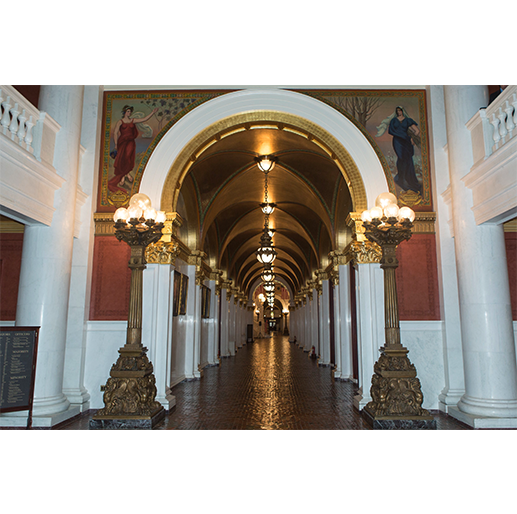
FALL AND WINTER

